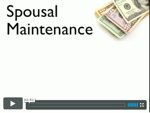This video discusses the options that you and your spouse have for making the big decisions in your divorce. We’ll talk about the difference between agreed and contested divorces.
Go to the Next Video in the Divorce Seminar Series
Go on to the next video discussing the next steps for you in your divorce.
There is a complete list of all the videos in the Divorce Seminar Series Videos at the bottom of the page.
About this Agreed and Contested Divorce Options Video
We’ve discussed the big decisions that you and your spouse will have to be making about your property, your children and spousal maintenance. At this point, there’s one question you need to consider…
How will you and your spouse make these decisions?
When it comes to making these big decisions, you and your spouse will handle it in one of two ways.
- Agreed
- Contested
There are several options along either of these two paths, and we’ll cover each of them in more detail.
Agreed / No Nonsense™ Divorces
In our office, we call this a No Nonsense™ Divorce. It’s a unique process in that we give you tools and resources that you and your spouse can use to work through the big decisions in your divorce on your own. The more that you and your spouse can work out on your own, the less you have to pay to lawyers.
I do want to point out that just because you and your spouse choose to work through the issues on your own, it doesn’t mean you don’t have support. Experienced legal advice is available with all of our No Nonsense™ Divorce Plans if you need it.
The primary tool we use is our No Nonsense™ Divorce Workbook.
It’s a step-by-step guide to working through the issues of your divorce on your own.
It also explains what the most common options are for these issues.
It’s very easy to understand and complete because it’s written in plain English (not Legalese) and it has convenient fill-in-the-blanks and checkboxes you can use to provide your answers.
We have No Nonsense™ Divorce Service Plans that cover a wide range of needs. On one end we can draft the documents for you and coach you so you can handle the rest of the divorce process on your own… To the other end where we provide you with full blown representation.
Contested Divorces
Contested divorces are for those couples that are unable or unwilling to reach an agreement on their own. If you are headed down the path of a contested divorce, you have several options you can use to try and make those big decisions.
Attorney Negotiated
In many cases, the simple step of adding attorneys to the negotiation can be all that was necessary to allow you and your spouse to come to an agreement on the big decisions. This isn’t unusual in situations where a couple’s ability to communicate effectively has deteriorated. Sometimes, negotiating through your lawyers can go a long way towards finding a resolution.
Mediation
There are two different types that we’ll talk about.
Mediation without Lawyers is also called early intervention mediation. It’s essentially an assisted settlement negotiation where neither you nor your spouse are represented by individual lawyers. The mediator is there to help the you reach an agreement and does not take sides.
It’s important to understand that mediators are ethically prohibited from giving legal advice to either party. So, even though you may have an attorney as your mediator, he or she cannot give legal advice.
Mediators are not always lawyers, so if you decide to use a non-attorney mediator, you may run the risk of reaching an agreement that isn’t legally enforceable.
Mediation is typically done in half day or full day sessions. If you are able to reach an agreement, you’ll typically sign a Mediated Settlement Agreement (or an "MSA") which outlines the agreements you’ve reached. Once it’s signed, it’s considered binding, and we’ll usually draft a Final Decree of Divorce that outlines exactly what the MSA says.
You also need to be aware of the fact that the Texas State Bar says it is unethical to have a lawyer that mediated for you and your spouse also draft your Final Decree of Divorce.
In Lawyer-Assisted Mediation, you and your spouse are both represented by your own lawyers.
There is also a neutral third-party mediator. The mediator does not offer legal advice and he or she does not represent either one of the parties.
In this type of meditation, you and your spouse would each be in a separate room with your own lawyer and the mediator shuttles back and forth trying to negotiate an agreement between you.
These are also typically half day or full day sessions and you’ll also usually sign an MSA if you’re able to reach an agreement.
Collaborative Law
There are also two ways that collaborative divorces are done so we’ll cover them both.
Before we go into them, I want to give you a little more information about the collaborative process. Collaborative law is designed for couples that want a private and respectful way to end their marriage. It’s a very unique and powerful process that is focused on finding a workable, long-term settlement that addresses everyone’s interests.
When there are children involved, their well being comes first.
The fundamental difference with collaborative law is that the parties sign an agreement that they will not resort to the courtroom to try and resolve their differences. This agreement is a very strong motivator for everyone to find a settlement that works.
The first way we do collaborative divorces we’ll call attorney-only collaborative.
This process involves a series of focused Joint Sessions that last about 2 hours each. Each Joint Session includes both spouses and their attorneys who work together to try and find options that meets everyone’s needs.
The preferred model of doing a collaborative case is to use a full team. In this model, a Joint Session typically involves both spouses, their attorneys, a Communications Facilitator, and often a Financial Advisor.
We can’t use a full team every time, but the benefit of it is that instead of relying on the attorneys to do everything, we bring in experts to deal with specific areas or issues.
For example, communication problems are probably the biggest difficulty that couples face during a divorce, so we use a communications facilitator during the collaborative process to help deal with communication problems. The professionals that we bring in are experts in their areas, and the process is much more efficient and effective when we use them.
Whichever of these two options you choose, the collaborative approach is a positive and productive process that focuses on finding an acceptable outcome instead of just "winning" or "losing." It’s is designed for people that want a more dignified way to end their marriage.
There is a lot more to the collaborative process, so if it sounds appealing to you, I encourage you to learn more about it by reviewing some of the other collaborative divorce information on our site.
Litigated
A litigated divorce is for couples that are unwilling or unable to reach an agreement on the issues in their divorce without going to court…or at least the threat of going to court.
In a litigated divorce, there is usually an exhaustive exchange of information through the discovery process.
And most litigated divorces will mediate at some point before they go to final trial.
There is also usually at least one hearing before final trial…most of the time that’s for temporary orders.
But one thing that many people don’t realize is how few litigated divorces actually go to final trial. You spend a ton of time, energy and money preparing for a trial, and yet almost all cases settle before the final trial.
How much will it cost?
I’ve said this before, but one of the most important things for you to remember when it comes to the cost of your divorce is that the more you and your spouse can agree on, the less your divorce will cost.
The other important thing I need to mention is that the figures that I am going to be discussing are the typical fees that we see in our office. I can’t speak for other lawyers, so I’m not necessarily talking about the total cost of a divorce.
Agreed / No Nonsense™ Divorce Cost
Initial retainers for agreed divorces range anywhere from $800 to $3,500. The range depends on how much you and your spouse agree on, how much property you have and whether or not you have children.
It also depends on how much attorney involvement you want. On the lower end of that range, we have packages that allow you to do almost everything yourself with our coaching. On the higher end of that range, we’re actively involved throughout your case.
With our No Nonsense™ Divorce packages, we do offer some flat fees, so this range includes both flat fee amounts and initial retainer amounts that we have.
There’s one other thing that I want to mention…in many No Nonsense™ Divorces, we are the only attorney involved, so in those situations, these fees may be the total cost of the divorce for a family.
Attorney Negotiated Cost
The initial retainers for an attorney negotiated divorce are typically between $3,500 and $5,000. In these cases, the more involved the attorneys are, the more expensive it can be.
Mediation Cost
I included mediation in this section because we’ve covered it as one of the options for reaching an agreement in your divorce, but it’s a little different from the other options we’re discussing.
I’m not going to include a range of fees here, because lawyer assisted mediation is usually part of an ongoing case, so the mediation fees are only a part of your cost.
Mediating without lawyers can be an inexpensive option, but you will also need to figure in the cost of having a Final Decree of Divorce drafted after you reach an agreement at mediation.
We use mediation most of the time during the course of an attorney negotiated or a litigated case where the parties have run into a particular issue that they want to try to settle using mediation.
Collaborative Law Cost
The initial retainers for a collaborative divorce are typically between $3,500 and $5,000. This can vary depending on whether or not you want to use the attorneys only or a full team and on the number of Joint Sessions necessary to come to an agreement.
Litigated Cost
Finally, the initial retainers for a litigated divorce generally range between $6,000 and $10,000. The retainers for these cases can be higher depending on the complexity of the issues involved.
Divorce Seminar Video Series
 Introduction and Divorce Basics Video
Introduction and Divorce Basics Video
 Children and Texas Courts Video
Children and Texas Courts Video
 Spousal Maintenance or Alimony Video
Spousal Maintenance or Alimony Video
 Agreed and Contested Options Video
Agreed and Contested Options Video




